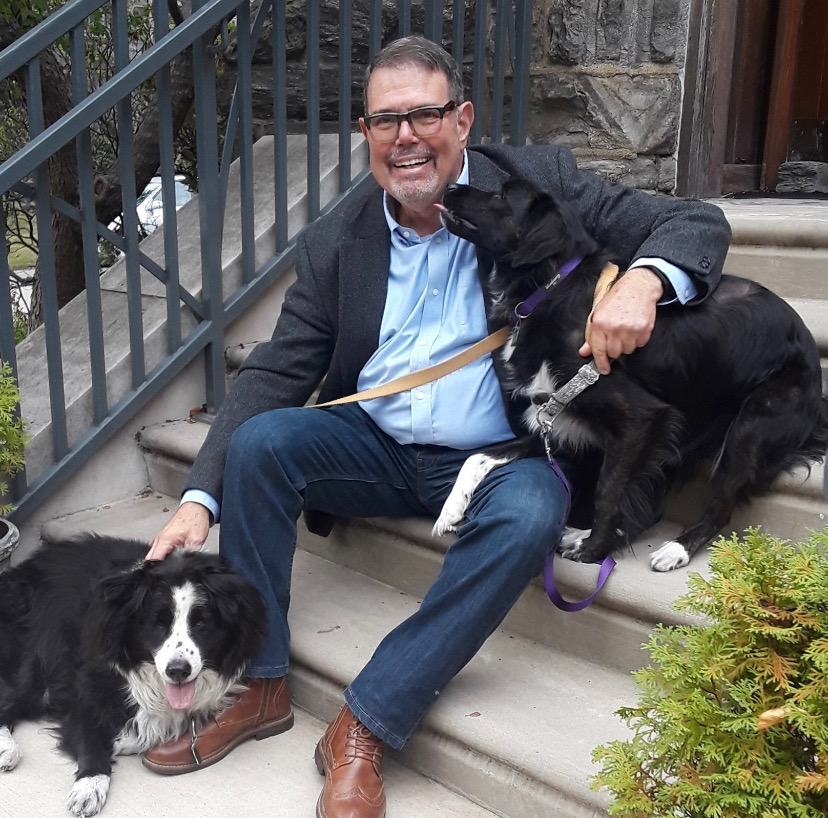Welcome to our newest blog series, “Five Questions With…” In this series, we will highlight the unsung heroes that make healthcare work. From guest services to the phlebotomist, the pet therapy volunteer, and the environmental services workers. These individuals enhance our experiences when we are getting care and highlight human connection and support. Thank you for all you do!
Today, we feature Fred Wolfe. Fred has been a volunteer in Animal Assisted Therapy (AAT) for six years.

Tell us more about what you do to support patients.
My dogs and I visit with patients and caregivers, as well as staff in the Roberts Proton Therapy Center. We try to offer a bit of diversion from the time they are waiting for their treatment and consults with their medical team. Our regular hours are Tuesdays, from 11 AM to 1 PM. We see patients over the course of their treatment, and frequently become one of the aspects of being treated at PENN that they look forward to. We’ve met a number of patients who stay in touch via social media long after their treatment ends.
As a cancer survivor and an alumnus of the Roberts Proton Therapy Center, I bring an additional perspective to our interaction with the people with who we meet.
We also visit other units in the hospital. Everything from the oncology units to transplant patients. We always check-in at the Welcome Desk to let the unit know we are there and spend some time with the staff. We let them know we are available to visit other patients as well. Patients can also request an AAT visit by asking their nurse to contact the Volunteers Office.
Is there one particular story that sticks out in your head about a patient you can share?
We met a young woman who was waiting for a transplant. Just before she was admitted she had lost her dog to a mysterious disease. When she saw Cene, she wept. We sat and listened to her tell us all about her dog. It was a struggle for her to speak. Cene rested her head on the edge of the bed and the patient stroked Cene as she continued to tell us how she found her dog and the adventures they had once shared. She mentioned she had no family to speak of, and that it was especially lonely as the holidays were approaching. I gave my word that I would be sure to stop to visit her whenever I was at the hospital. I saw her every few days for the next couple of weeks.
It was difficult to not be thinking about her and her loss on top of her physical struggles. I wanted to do something to acknowledge her loss and so I found a dog figurine that was close to how she had described her beloved dog. The figurine even had angel wings. It came just in time that I could give it to her on Christmas Eve. When we got to the unit, I was mortified to find her room was empty. Asking a nurse, I learned that she had been moved to an isolation room. I had gotten to know her nurses and when they saw Cene and they looked both panicked and relieved. They explained that she a taken a dramatic turn for the worse.
I showed them the figurine I had brought, and they immediately knew it represented her dog. It was passed to a nurse who was already in the room who also reacted strongly when she saw it. She bent over and whispered that her friend with the dog was there and that I had brought a gift. She carefully described the figurine and told her she was tying it up over the bed so it could watch over her.
We shared hugs and tears with the nurses on our way out. Several of them thanked us for caring about that patient, that she always seemed calmer and stronger after our visits, and that we had helped her navigate through a very difficult time.
What is the thing you love the most about your job?
When I can engage people in a conversation about Animal Assisted Therapy vs. Service Dogs or when I can have a conversation with someone who would like to do AAT with their dog. It’s the best feeling when you can encourage that dream.
If someone was applying for a similar position, what would you tell them about the work?
How rewarding it is, how it helps keep you grounded, and how it will strengthen the bond between them and their dog.
What is a job accomplishment that you are proud of?
When I first started bringing Papagana to HUP, she was not really used to being around children. The first few times we encountered children if she didn’t feel comfortable with what they were doing she would growl, which frightened the children and embarrassed me. I found that if I sat on the floor next to her it made her feel more secure. Eventually, she grew to tolerate children. She barely noticed the last Bring your Child to Work Day when our elevator was suddenly filled with a dozen or so youngsters.
When I started to work with Cene, I wanted to be sure she would be comfortable with children, so I walked her every day when kids were on their way to school. As a result, Cene absolutely adores children. When she sees them her tail twirls twice as fast. She gets very concerned over crying children. She loves her bi-monthly “Read with a Therapy Dog” hour at the local library.
Do you want to nominate a staff member, volunteer, co-worker, or friend for us to feature in “Five Questions With…” Go to oncolink.org/feedback and let us know!